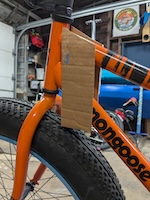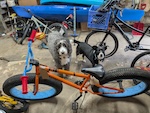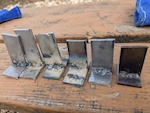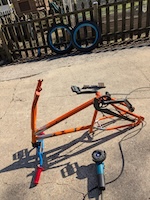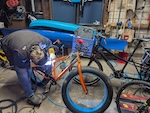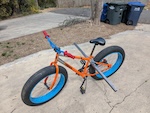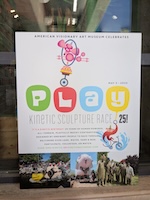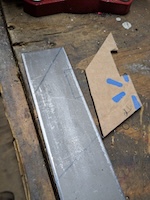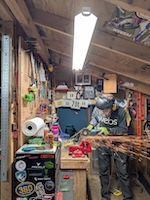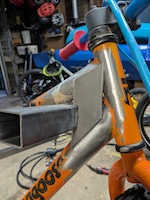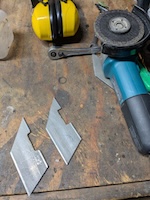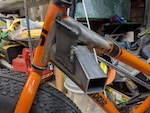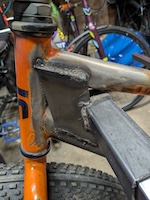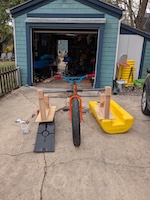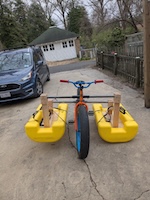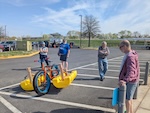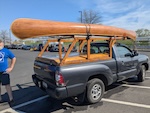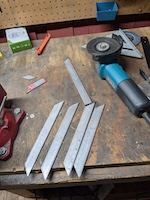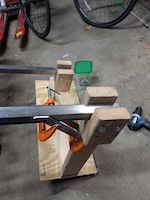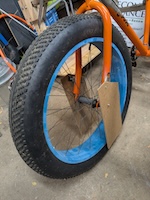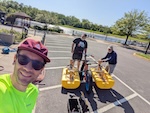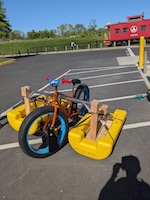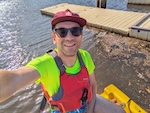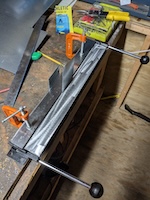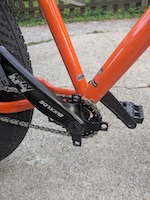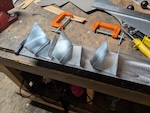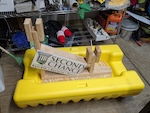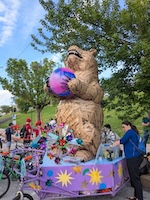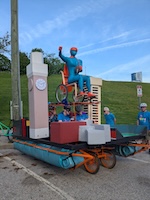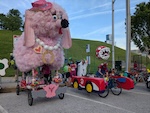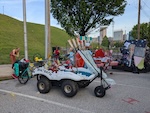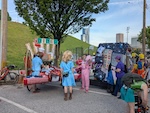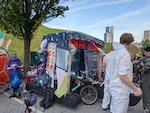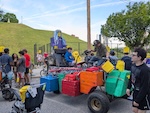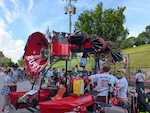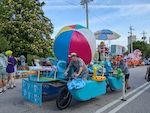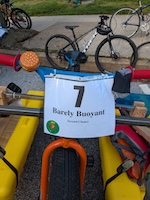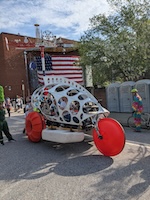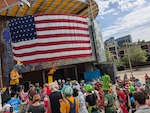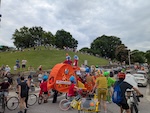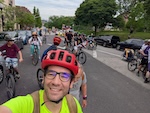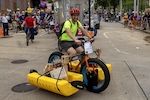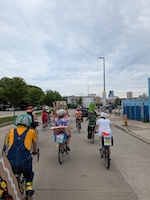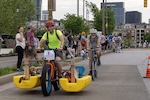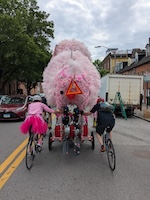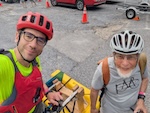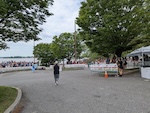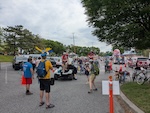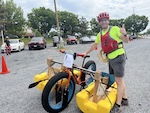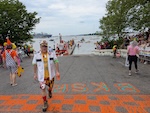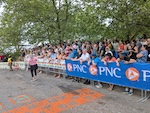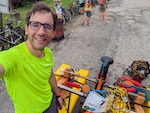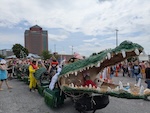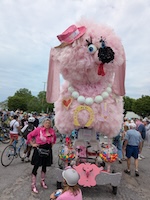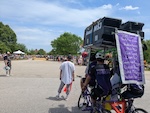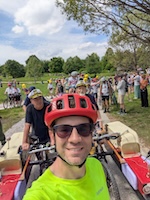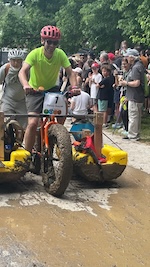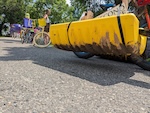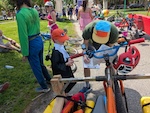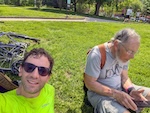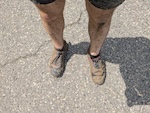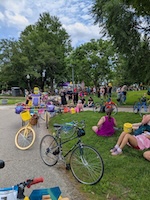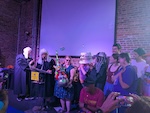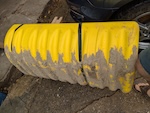Baltimore Kinetic Sculpture Race
At this point it's well known that I like building stuff and if it's something silly that makes people happy, even better. I've had plenty of fun with the ski horse and the Hampdenfest Toilet Races are no more so I was jonesing for a project to build over the winter to avoid the usual maintainance work on my old house.
I had heard some chatter about the Baltimore Kinetic Sculpture Race during the toilet races since there's a good deal of overlap, both in the people, vibes, and building skills so I decided that's what it was going to be. I had 5 months to plan and build something for the race on May 3rd
The race is best described as a giant rolling art party / bicycle parade and is much more about celebrating creativity and fun rather than actually racing, but nonetheless the size and level of engineering in some of the entries is truly impressive. I decided to set some reasonable goals for the first year.
Goals
- Show up and complete the race start to finish.
- Build something that floats and could go through the water (not all entries do).
- Something that could break down and fit in my van/storage space at my house. I have a small garage and didn't want to deal with a trailer behind my van
Building It
I had learned a good deal from the toilet races about building things like this. The more wheels and larger something is, the more complicated and difficult the engineering is to get correct. I knew I would either go with 2 wheels or 3 to avoid alignment issues that come with 4 wheels. I also decided starting with a bike as the base is much easier so I started to hunt around for fat tire bikes that might work with the plan only partially complete in my mind.
Given that the bike was going to get really wet, I wanted the most mechanically simple bike I could find and hit a jackpot on Facebook Marketplace. A Mongoose Dozer single speed fat bike with a coaster break. No deraileur or brake cables would be a very large plus. It would be dead simple reliable and should be fine in the water. I drove an hour and 20 minutes to get it and it was worth it.
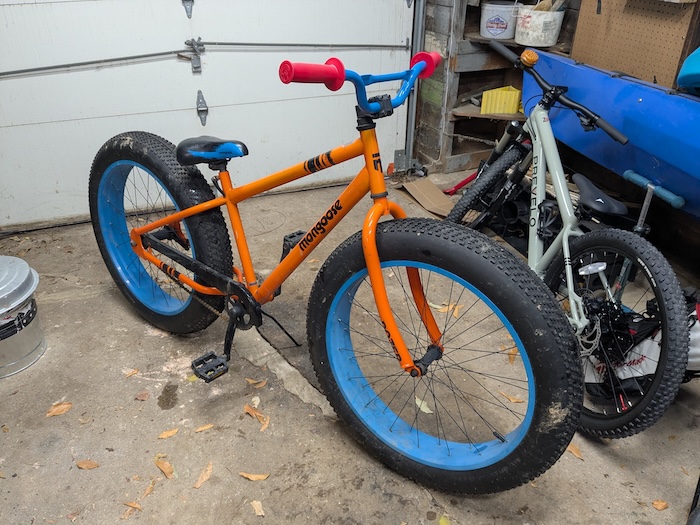
I gave the bike new grips and a quick tune up and then started plotting the rest. I knew that the bike needed pontoons out on both sides, but hadn't thought too much about exactly what would work. My Dad works at Second Chance (construction materials re-use warehouse) and knew what I was up to so he was on the look out for something that would work as a set of pontoons. He managed to get a pair of parking garage barriers which would definitely work and any sort of new set of pontoons I was looking at were $400 or more. Second Chance also agreed to sponsor my entry and kindly donated them to the cause. Norm who works at Second Chance also joined the team and provided plenty of good pieces of advice. I looked them over, calculated about 200lbs of net bouyancy from each barrier and decided to make them work. Compared to actual pontoons they are VERY heavy, but they're also built real strong since they're designed to be smacked into by cars.
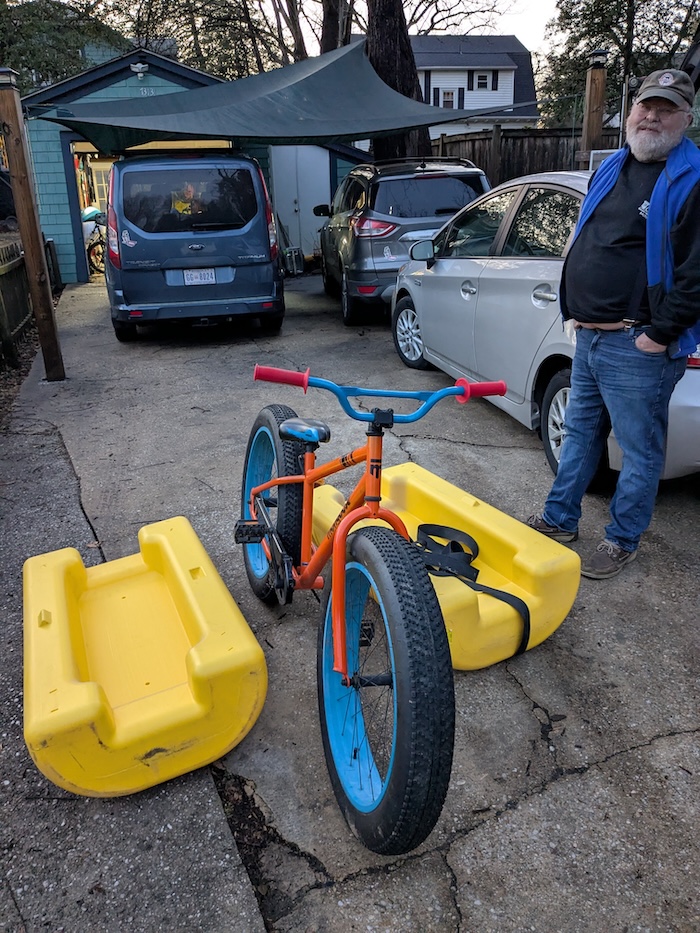
I would need to build out about 2 feet on each side from the center of the bike. Given how much strength was necessary over those 2 feet and also options to attach a pontoon frame to the bike, the only option was welding steel to the bike frame. I had only ever done stick welding 20 years ago so I watched plenty of online videos and consulted with a friend who welds professionally. I pulled the trigger on a Yes Welder 205 DS Pro which is a combo machine (Stick/MIG/FluxCore/Lift TIG) and probably has more online tutorials on how to use it than anything else out there. My garage only has 120V power and I also wasn't sure if that would be enough rather than 240V to weld what I needed to. I also grabbed an auto tint helmet which was drastically easier than the old style dark only masks I'd used before.
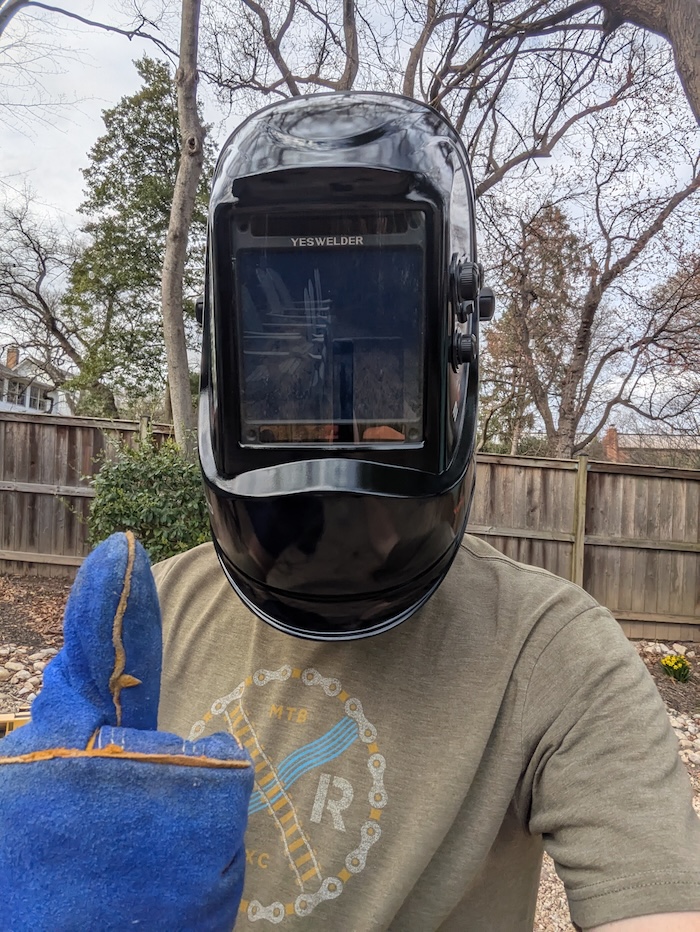
I got everything setup with the welder to test some Fluxcore welds and everything worked out great. I was surprised the breaker in my garage didn't trip and it looked like this setup would actually work. I started to plan where I could weld in 2 large pieces of square stock steel through the bike frame and still be able to remove them for storage. This would have to be a compromise between where was strongest on the bike frame to weld, but still didn't get in the way as I pedaled. I started to mock up the frame brackets with cardboard and stripped the paint off the bike where we needed to weld. At this point I wasn't confident enough in my welding and didn't want to melt the bike frame so I had my friend Adam come over and he welded in the back bracket with his much nicer TIG setup. It turned out great and this project had felt pretty crazy and possibly unachievable before this and I started to gain confidence that we could actually pull this off.
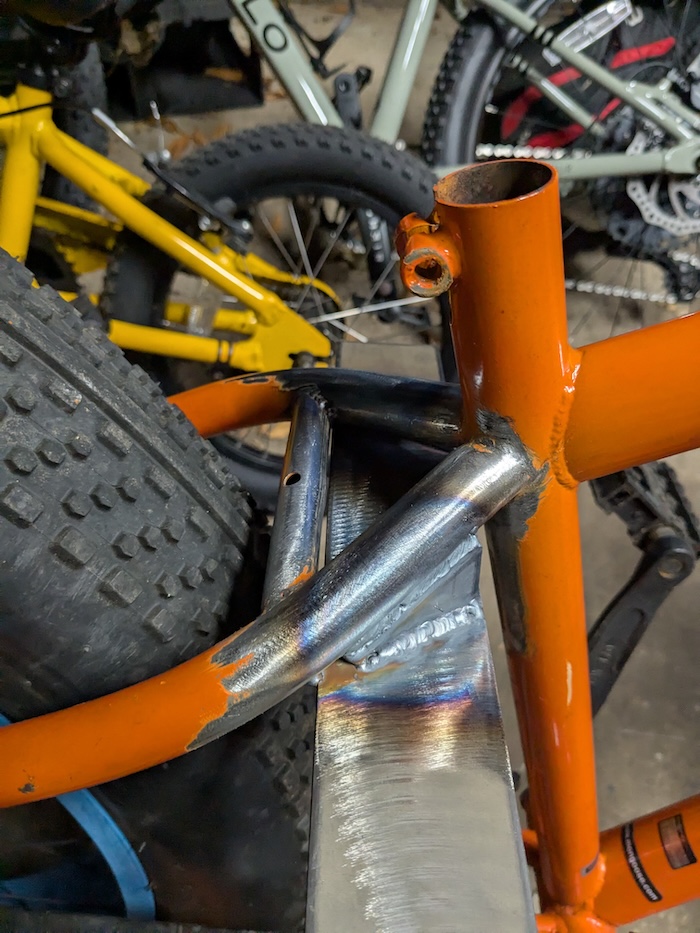
The Baltimore Kinetic Sculpture Race is actually put on by the American Visionary Arts Museum (AVAM) so we took a family trip up there to scout out some of the racers that live there permanently. The museum is fantastic and we checked out Fifi and Tick Tock the Croc that live there permanently in the barn. We also chatted with some folks who were very psyched to hear that we were a first year team building something new.
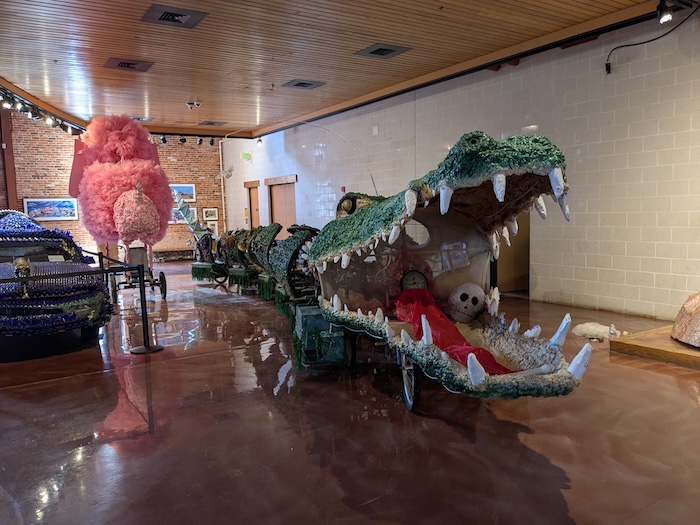
Things were moving in the right direction and I officially registered our team for the race. I started to plan out the front frame brackets and cross piece for Adam to weld, but then practiced more and got confident enough on the welding myself to go for it. The Fluxcore welds definitely weren't as clean as the TIG welds on the back frame bracket, but they were solid enough to get the job done and I was confident they'd hold during the race. I melted one small hole in the frame too, but had watched Adam fix the same issue and let things cool down enough and was able to patch it up. The bike now had 2 large pieces of square stock steel that could be installed/removed to support the pontoons. I REALLY started to feel some momentum now because the most difficult part (the welding) was done.
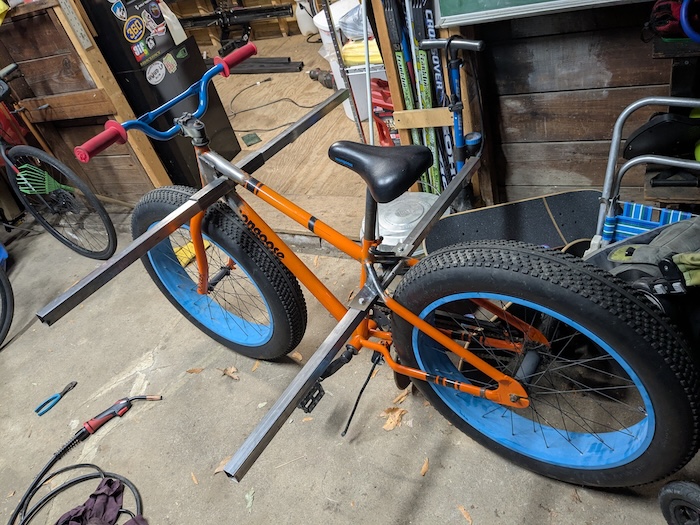
The pieces of steel running out to the sides of the bike would support the two large yellow pontoons, but the pontoons definitely needed to be lower to keep most of the bike out of the water. I'd need to build pontoon frames down off of the steel square stock pieces and then attach the pontoons. I determined the middle point of the bike where my weight would be and was going to try to keep the pontoons 5" off the ground.
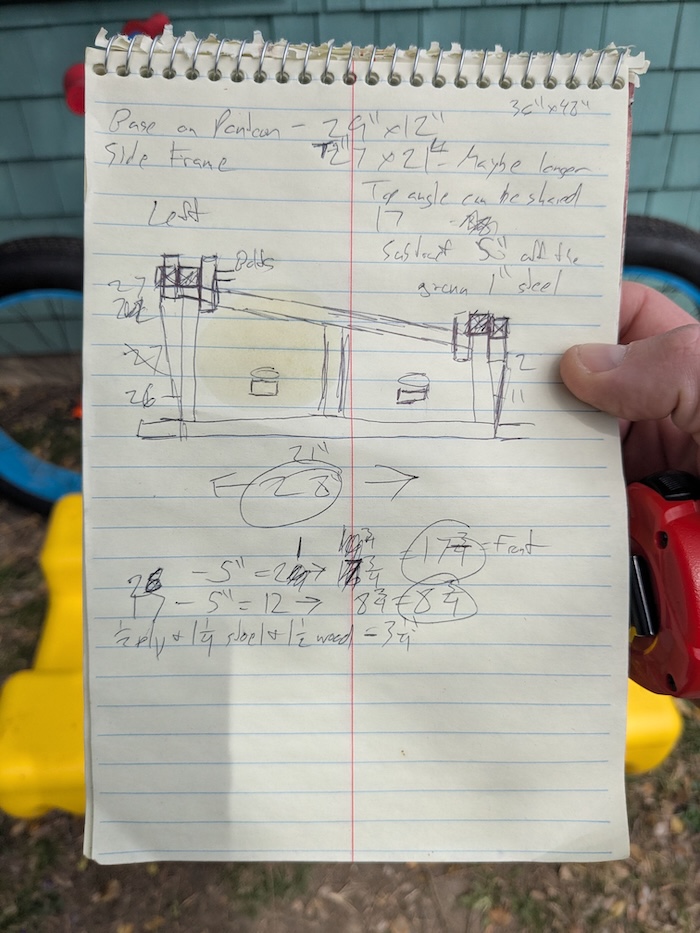
I was not at all confident that I'd get this right on the first try to float stably, so I built the pontoon frames out of wood so they could easily modified later if needed. Attaching them to the pontoons was also tricky since I didn't want holes in the pontoons, but luckily ratchet straps worked just fine. The wooden pontoon frames bolt onto the square stock steel and I added some more braces just to reduce the stress on where the wood bolted to the steel.
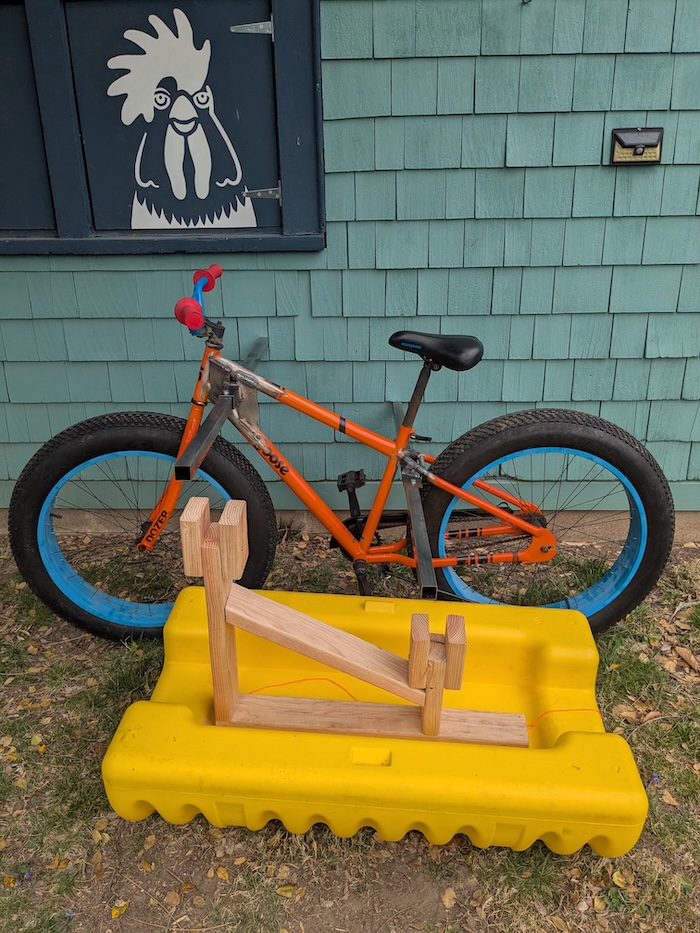
I took the bike for a ride around the neighborhood and as predicted... it rode absolutely horribly. Partially due to the weight, also the stock gearing, and the headset bearings were bad as well too. Despite all of this I had something that I could ride around and was pretty confident would float on the water!

Before I kept working I wanted to make sure it would float stably so we scheduled the first sea trial over at Bladensburg Waterfront Park just to see how it felt in the water. I launch my kayak out of here and have never seen an actual boat launch here due to this section of the Anacostia being blocked by a low bridge, but there is a boat launch which would work perfectly to ride into the water. My Dad, Norm, and Mike came out for support and I eased the bike into the water and surprisingly everything felt great. It sat just deep enough in the water, was stable front to back, and also side to side. I pushed it out of the water and we all celebrated. A few other folks had questions about the bike and were excited to see it and had heard of the Kinitic Sculpture Race. There was also someone there with a beautiful wooden kayak and matching truck rack they had made who chatted with us for a while.
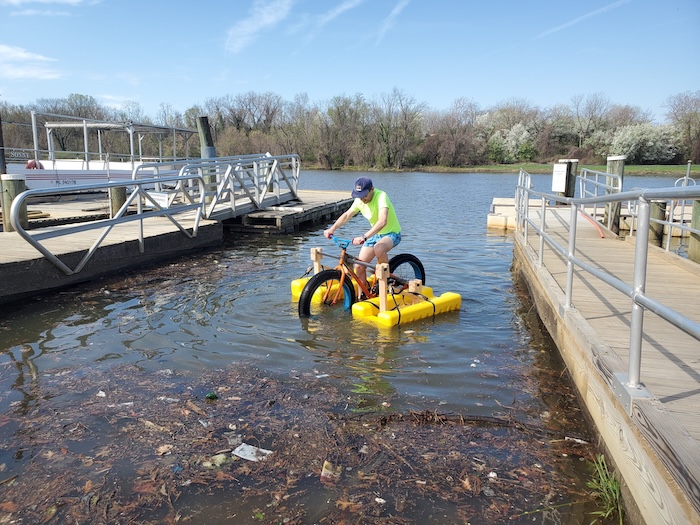
I was now VERY confident we were going to make it to race day. There were two major issues left to tackle. Propulsion and steering in the water. I had rough ideas for both of them that weren't going to be too difficult to make work. My plan for propulsion was to build small pieces of metal attached to the back wheel spokes to act as a water wheel. One key thing I had tested is that I only wanted the bottom 10" or so of the rear wheel in the water. As the wheel spun the small pedal pieces would push the entire bike forward like the water wheel on the back of a steamboat. I borrow a small metal bending brake from my dad, figured out the right size and angles with cardboard, and then bent pieces of sheet metal and attached them to the spokes with cable ties.
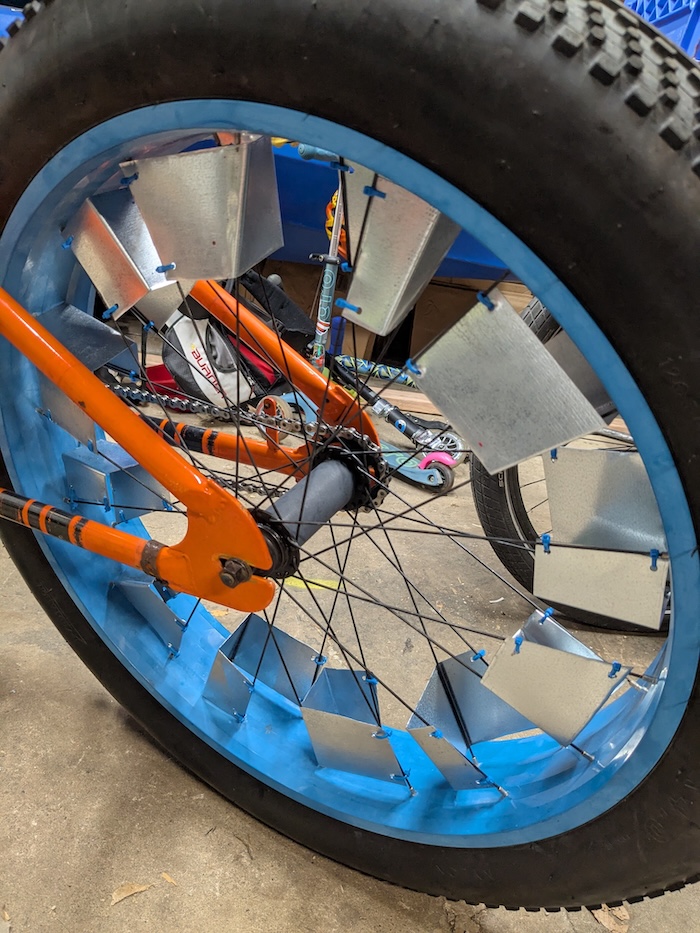
The only issue left was steering in the water. My plan was to build two blades down off of the sides of the front fork which would act as a rutter. When the front wheel turned to either side, the water would run over the blades and push the entire bike to either side the same way the bike would steer on the land. The front fork had threaded rack mounts, I welded an additional bracket on each side, and went with 1/4" acrylic for the blades themselves. Sheet metal would have been too flexible and thicker steel would have been very heavy. This would hopefully work nicely because the bike would steer the same way on both land and water by just turning the handlebars.
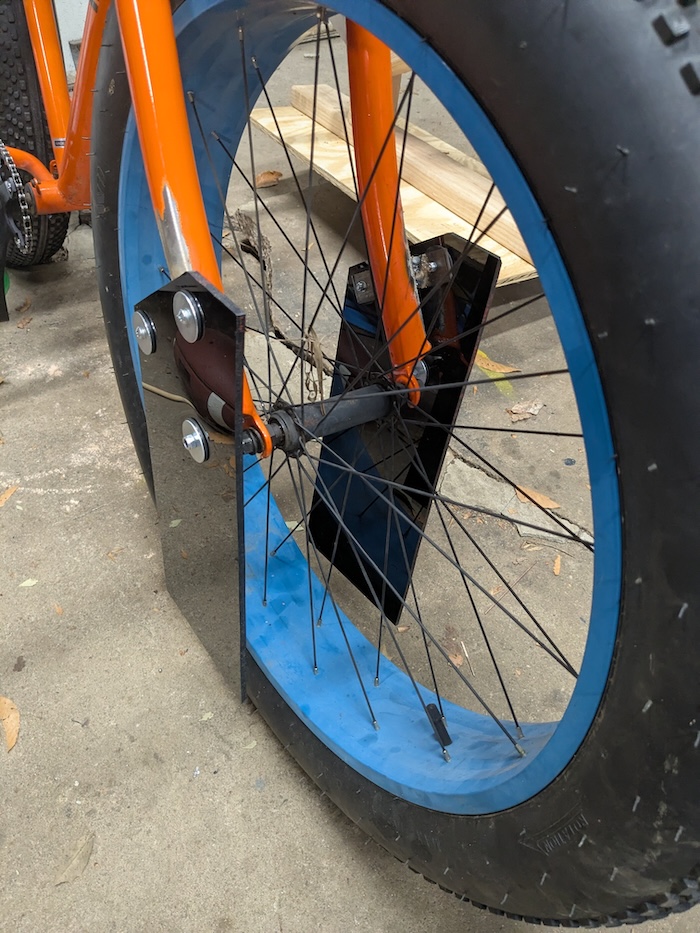
I now had a bike that I was confident would float, should move forward in the water, and hopefully steer so I went back to Bladensburg Waterfront park. It happened to be an extremely windy day (more on this later) and I rode a few laps around the parking lot and then headed into the water. I had to ride through a massive amount of garbage in the boat launch and then started to pedal.Nothing went right at all. The design of the water wheel paddles I had used was a V shape which was not pushing the bike forward much, but was just flicking a massive amount of water up in the air. The bike couldn't make enough forward momentum to see if the rudder worked either. I VERY luckily thought to take some rope with me if I needed it and I needed it. The wind started to blow me down the river and the only way I made it back to the dock was by throwing a rope to Norm on our team and having him pull me in.
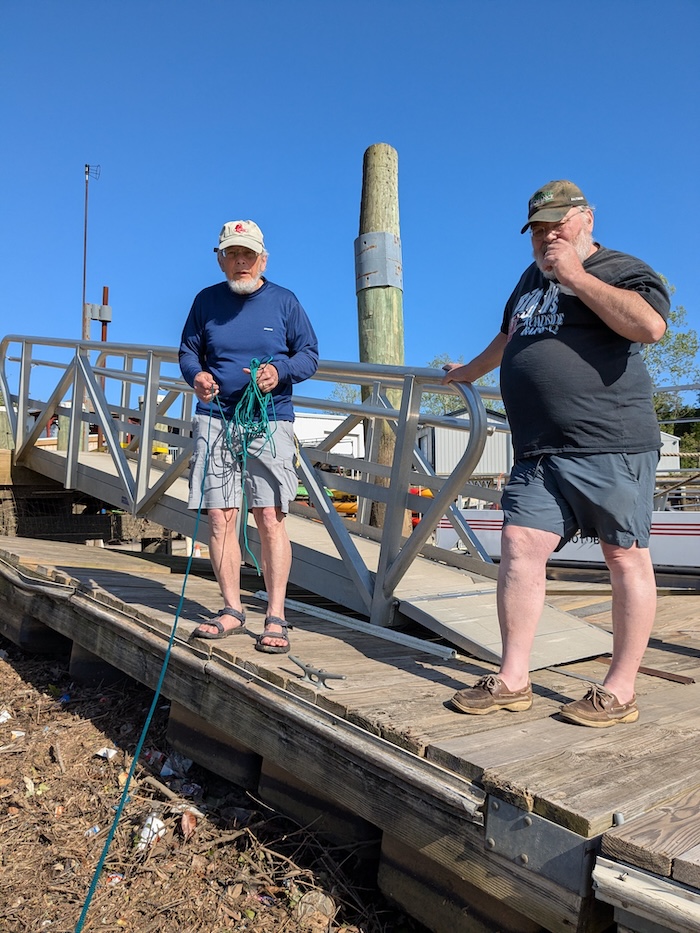
The trial did not go well, but I learned a few key things. I had one week until the race so anymore tests were going to wait until race day. I put new cranks with a 22T chainring on the bike which made it much easier to pedal, tuned up a few odds and ends, put on some Second Chance signs, rebuilt the fins on the water wheel to be wider and flat, setup a toolbox and backpack with everything I needed to break it down to fit in my van, assemble it at the race, and then hopefully fix it if anything went wrong.
Race Day
I arrived nice and early since I wanted time to assemble everything and there's also a safety/tech inspection before the race starts. Norm and my Dad met me there and everything went great getting the racer put together. It was a pretty funny scene in the nearby parking lot as everyone was unloading their racers, scrambling to put them together, and then ride down the hill to the start.
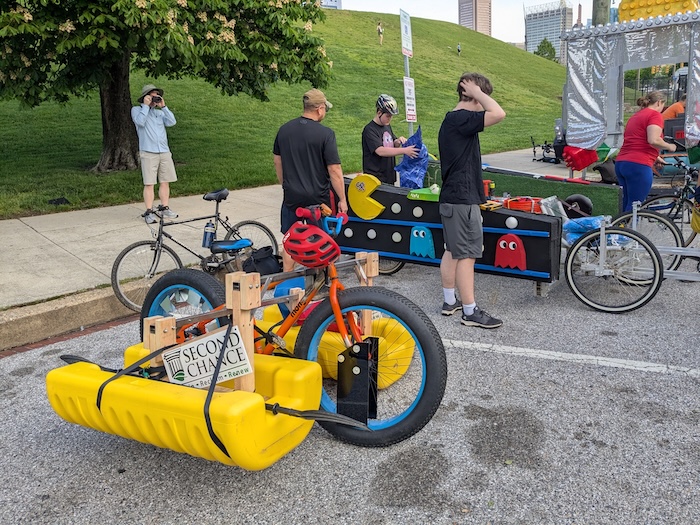
I could try to describe all of the amazing 30 different race entries there at the start, but it's probably the highest density of raw creativity you will ever see anywhere. There's tons of great photos and videos below and online to checkout and as expected everyone there was incredibly nice. A judge came by for inspection and we passed everything (there's actually about a dozen rules and requirements) and the only one I wasn't ready for was a bribe for a judge when asked. Unsurprisingly I did not win the best bribes award later at the awards ceremony.
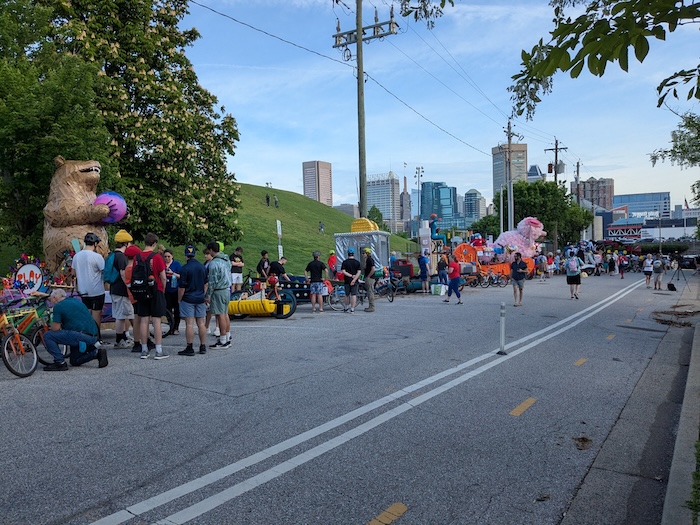
They hyped everyone up and then we all ran down the hill for a Le Mans start and all scrambled to start moving while bunched together and then eventually spaced out a little as we went out on the road. The bike felt great, but is an absolute pig to get started moving if you're on an uphill even with the easier gearing. We looped through Federal Hill Park where everyone was chearing and then headed out on to the streets of Baltimore through the inner harbor. This part of the race was an absolute blast and I recieved probably about a hundred shout outs about Second Chance from groups of people setup all over to watch the race. Norm also rode with me for most of the race too so I felt like less of a lone wolf.
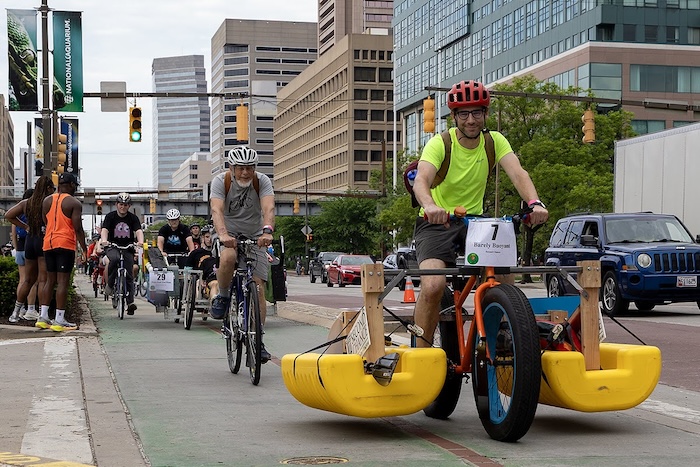
I made it to Canton Harbor nice and early. They checked me over for a few water safety rules (need a life vest, rope, tow point, etc.), put me in line, hyped up the crowd, and then sent me in.
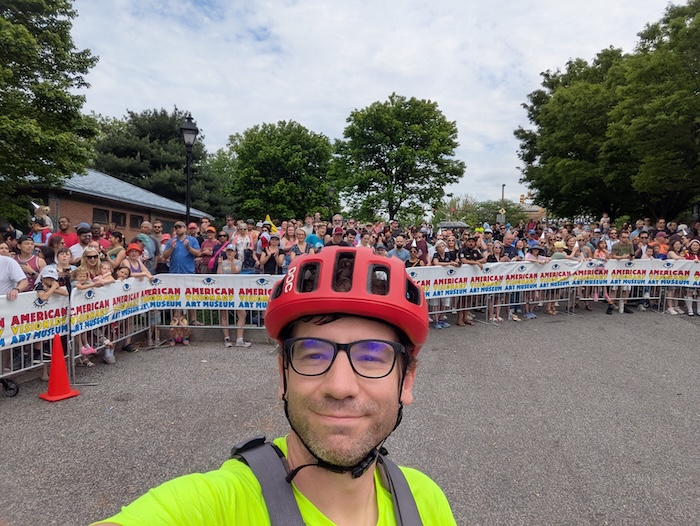
Entering the water went great and as I had hoped, the new water wheel design worked much better. The bike was moving forward no problem. I needed to make a 180 degree turn at the end of the dock and the rutters off the front fork did work, but much slower than expected. The bike make a nice big wide sweeping turn and then I was headed back to the boat ramp. I started to pedal as fast as I could to try to get a clean exit from the water while keeping my feet on the pedals and it was tough, but I succeeded and grinded up and out of the boat launch.
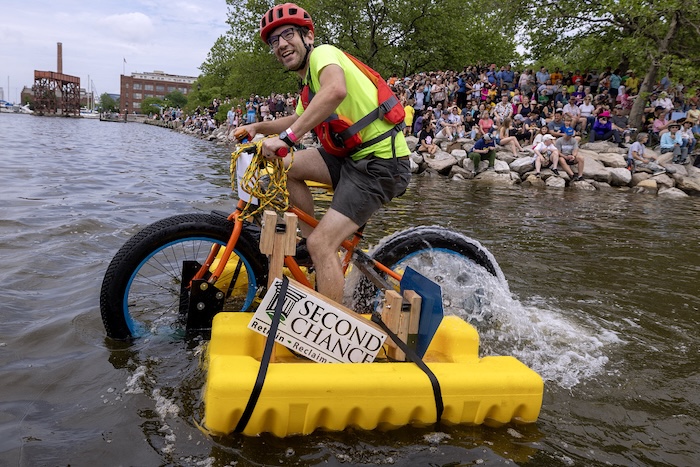
The water obstacle is probably the most intimidating part of the entire race and I was glad it went so well and it was now behind me. Some entries also opt to skip the water (they're call the Bush League entries), but tackling the water made the engineering much more fun to think through on this project.
The way the race works is that they kind of stage everyone in 3 different areas/section of the route so that way we're all only on 1/3rd of the course at a time. This helps limit the work of police shutting down the roads and also makes it more fun because everyone is kind of nearby each other. After getting out of the water we had to wait a bit for everyone else to enter and exist the harbor. A bunch of friends and family stopped by and they had food trucks nearby too. Some teams had organized friends bringing nice big picnic lunches here and it was a fun vibe catching up with everyone. They gave us a 15 minute warning and then we all headed out for the second part of the race.
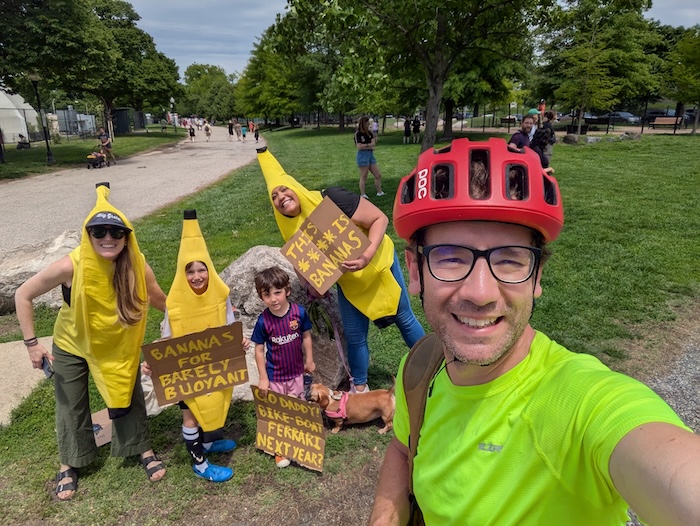
The second section of the race is mostly focussed on Patterson Park. I ran into Katie, my boys, and a friend here all dressed as bananas cheering me on. The course goes all around the various trails in the park and first up was the sand obstacle. This went pretty well and my only strategy was just to ride fast and stay straight and upgright and it went perfectly thanks to having massive tires at low pressure.
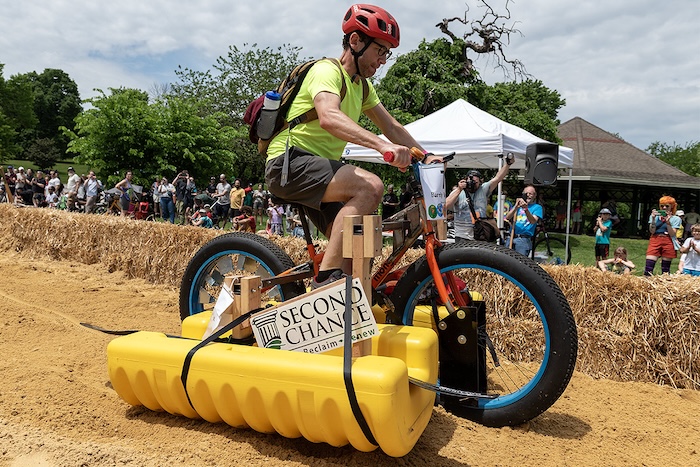
I got a little lost on where I was going after the sand and then someone on a unicycle flagged me down and lead me back to the race course. I found my way to the next obstacle and lined up since they were only letting one racer through at a time.
We waited on a narrow path leading up to some mud, but there was no way to really tell how deep the mud was. I had heard from others it was rediculously deep and before the race I had just assumed I'd be dealing with a few inches of mud in the grass. I have no idea how they did it, but what the obstacle actually consisted of was a foot of extremely soupy sloppy mud on a slight uphill for at least 50 feet. I didn't know this so my only strategy was to pedal as fast as possible at it, get a good grip on the handlebars, see what happens, and then try to pedal out.
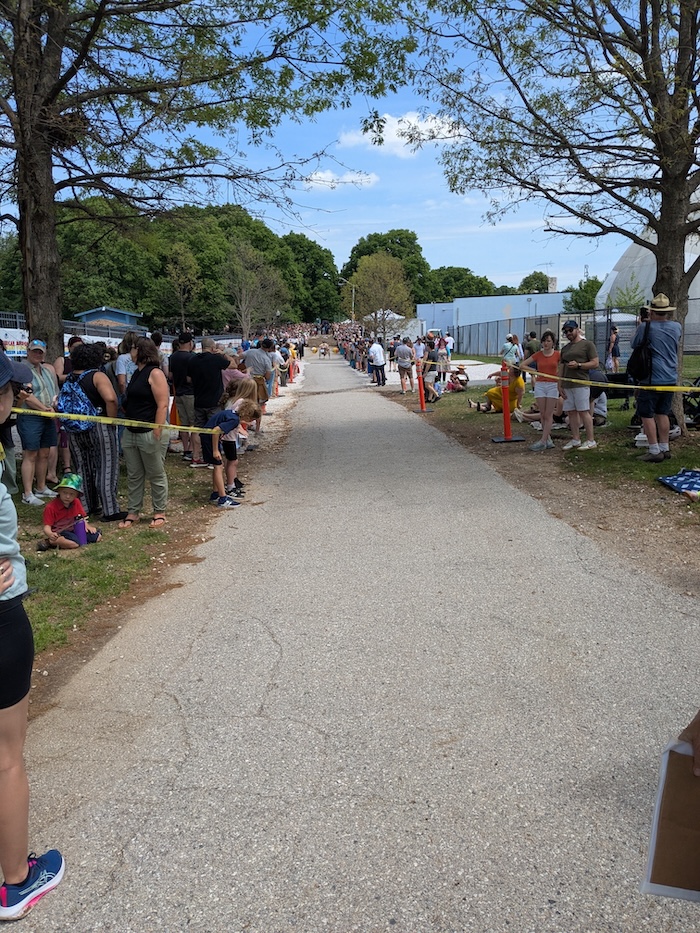
My pontoons are only about 5" off the ground so as soon as I hit the mud I came to a complete stop within maybe 5 feet and both pontoons suctioned completly into the mud. Some volunteers helped me lift the bike up in the air despite how much it weighed and we carried it up the hill. They hosed me and the racer off the best they could and I took a few minutes to decompress.
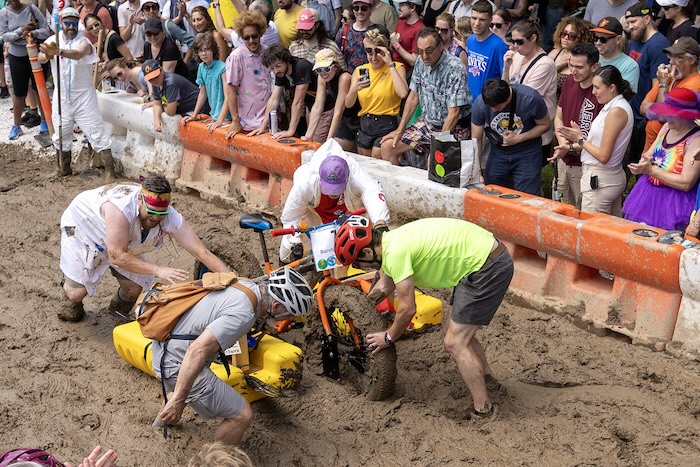
From here I cycled up to the top of the park exhausted from the mud and everyone waited up there resting under trees for the 3rd part of the race to begin. We laid out on the grass for about an hour as everyone made there way to the top of the hill at Patterson Park and then they let us loose for the final leg of the race.
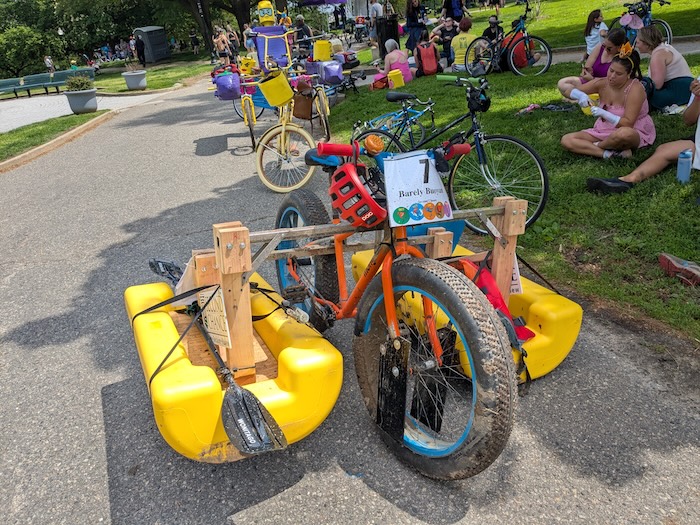
The home stretch is an easy cruise mostly down hill and a few last minute turns to end up back infront of the museum. I've had my share of injuries and it always happens doing the easy part of a trip or the thing where I shouldn't get hurt and this was no exception. Some kids were riding by in the opposite direction and wanted to give me a high five which I pulled off without ramming them with the pontoons, but when I turned away from them I over compensated and smacked the entire rig into a fence post. I was shaken, but overall felt fine and was only a mile from the finish so I just pressed on. At this point I knew I was gonna make it and was only a few blocks from the museum. People were cheering on the last few turns and they put out a tape to bust through at the finish line. It felt great to be done and I pulled up to the one other entry that had beat me. They were a boys highschool mountain bike team who were really fast as they should be.
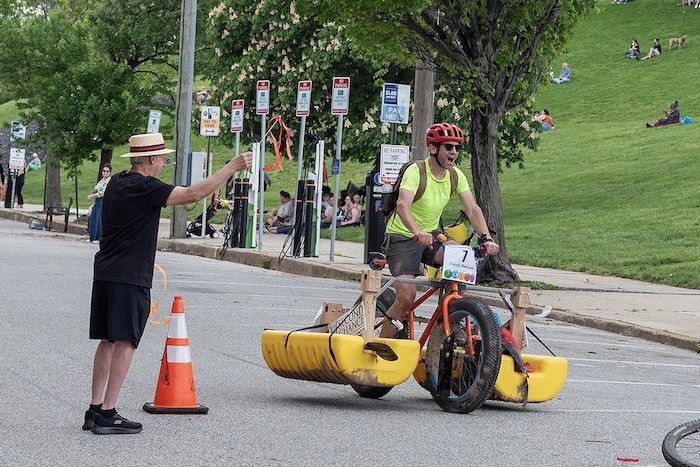
My family was there to cheer me on through the finish and came up to where I stopped the racer. I was so happy to see them and to be done. This entire thing was a lot to plan and build and the race itself was actually pretty tiring pedaling this thing all over Baltimore for a day. Free food and beers were included in the registration so I pigged out and cheered the rest of the racers on as they rolled in. A proper meal and a few beers and I felt totally restored. I had a massive golf ball sized lump from my knee smacking into the metal square stock pontoon frame so I grabbed a few ice packs from the EMTs and it eventually felt better. It was great to catch up with everyone about how the race went and then we all started find seats for the awards ceremony.
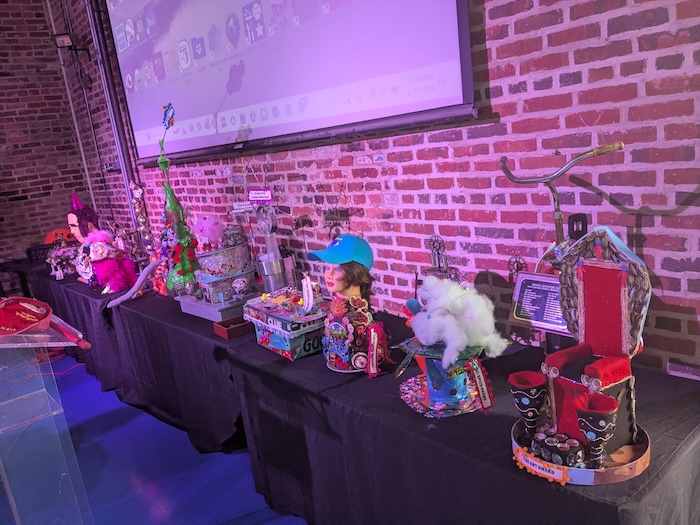
The after party and the awards ceremony is probably the best vibe of any place I've ever been to. You're there with a hundred other out there weirdo creative people who've all just finished a long day (and a lot of prep) to do something for no other reason than just for fun. All teams get medals and then they go into about a dozen or so individual awards including Best Bribes for the Judges and Best Breakdown. It's a combination roast and celebration of creativity and all that AVAM and the race embody and celebrate. Things wound down and I still had to break the racer down and get it back into the van. It started pouring out causing all the dried mud to begin sliding off the pontoons and I scrambled with Norm to get it back in the van quickly. The rainy drive back to DC felt great knowing I was done and had accomplished all of my goals for my first year in the race.
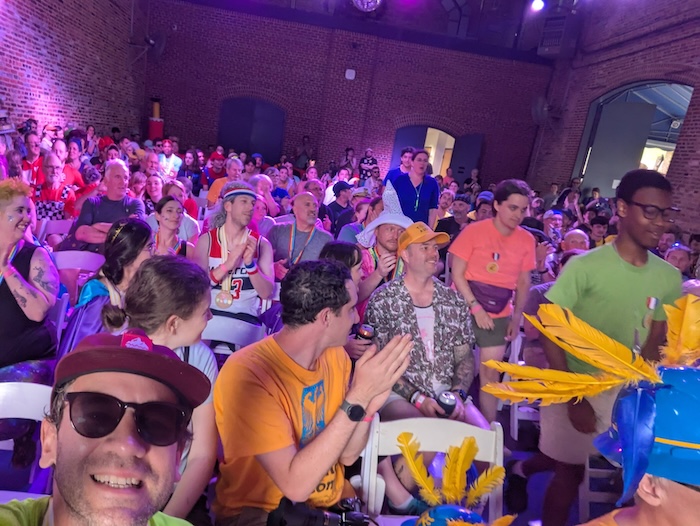
Hindsight
This is one of my favorite events I've ever participated in and I thought about why a bit:
- I've built a lot of stuff, but it's been a while since I wasn't sure I could pull something off. Finishing this really felt great because there were points where I wasn't sure it would all come together and actually work.
- The people involved in running the race and all of the teams are incredibly nice, fun, and creative. AVAM does a fantastic job of making it feel like a community and I felt just as welcome as people who've raced for over 20 years.
- Doing something silly for no other reason than just to make yourself and a lot of other people smile
I have some notes for next year on how to improve the racer and a few friends want to get more involved too. I'll start planning for 2026 (the race is on May 2nd) sometime around the holidays and already have a few ideas bouncing around in my brain.
The race has a great photography team covering the event so a massive thanks to them for taking some of these photos.
More Race Coverage
- Some great photos of myself and Norm during the race./li>
- Checkout all the racers here.
- Baltimore Banner
- The New York Times (there's actually video of me in the article)


